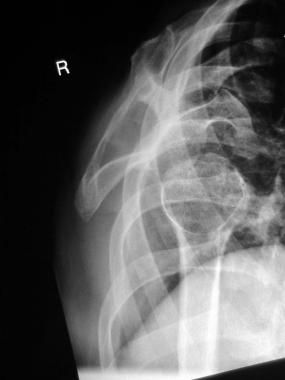

Shoulder dislocation is documented in Egyptian tomb murals as early as 3000 BC, with depiction of a manipulation for glenohumeral dislocation resembling the Kocher technique. Hippocrates detailed the oldest known reduction method still in use today and advocated treating chronic shoulder instability with cauterization of the deep tissues of the anterior shoulder.
Historical techniques to reduce dislocated glenohumeral joints have been shown to be safe when applied correctly. Kocher's method as originally described in 1870 did not involve traction and fell into disfavor when complications occurred with the application of large forces. Most dislocations are anterior, but less frequently, posterior, inferior (luxatio erecta), superior, and intrathoracic dislocations are also possible.
Recent data indicate that arthroscopic stabilization is performed in nearly 90% of shoulder stabilization surgeries in the United States. The percentage of arthroscopic stabilizations increased from 71% of stabilization procedures in 2004 to 89% in 2009, whereas the percentage of open stabilizations decreased from 29% in 2004 to 11% in 2009 (P < .0001).[1]
NextThe shoulder is the most frequently dislocated joint. It moves almost without restriction but pays the price of stability. The shoulder's integrity is maintained by the glenohumeral joint capsule, the cartilaginous glenoid labrum (which extends the shallow glenoid fossa), and muscles of the rotator cuff.
Anterior dislocations occur in as many as 98% of cases. Anterior displacement of the humeral head is the most common dislocation seen by emergency physicians and is depicted in the image below.
 Y-view radiograph of the right shoulder shows anterior dislocation of the humeral head relative to the glenoid fossa.
Y-view radiograph of the right shoulder shows anterior dislocation of the humeral head relative to the glenoid fossa.
Posterior displacement is the next most frequently occurring dislocation. Inferior (luxatio erecta), superior, and intrathoracic dislocations are rare and are usually associated with complications.
Shoulder dislocations affect approximately 1.7% of the population and are most frequently secondary to trauma. The incidence of all traumatic shoulder dislocations has been estimated at 11.2 cases per 100,000 person-years, with a cumulative incidence rate of 0.7% for men and 0.3% for women up to age 70 years.
A Danish study estimated the incidence of shoulder dislocation at 17 cases per 100,000.[2] In a random sample of people in Sweden, 1.7% reported a history of shoulder dislocation.[3]
A more recent Greek study examined the demographic data and recurrence rates of shoulder dislocations of 308 patients (170 men and 138 women).[4] Subjects were observed for approximately 6 years. The most frequent mechanism of injury was falling, and 92% of reductions were in the ED. The overall recurrence rate in all ages was 50%, but rose to almost 89% in the 14-20 year age group.
Gender distribution is bimodal, with peak incidence in men aged 20-30 years (with a male-to-female ratio of 9:1) and in women aged 61-80 years (with a female-to-male ratio of 3:1).
Shoulder dislocation occurs more frequently in adolescents than in younger children because the weaker epiphyseal growth plates in children tend to fracture before dislocation occurs.
In older adults, collagen fibers have fewer cross-links, making the joint capsule and supporting tendons and ligaments weaker and dislocation more likely.
Anterior dislocation is most commonly seen in those aged 18-25 years due to sporting injury. The second most common age group to sustain anterior dislocation is in elderly persons due to their susceptibility to falls.
Age is a major factor in the likelihood of sustaining a recurrent shoulder dislocation.[5] Approximately 80-94% of patients younger than 20 years at the time of the initial dislocation have a recurrence. The major pathology in this age group is thought to be a Bankart lesion with associated inferior glenohumeral ligament injury.
Of patients younger than 40 years, 26-48% develop recurrent dislocation. The major pathology for this age group is thought to be disruption of the labral attachment of the glenohumeral ligaments. Dislocation recurs in only 0-10% of patients older than 40 years. Rotator cuff tear is the major pathology.
Minor trauma that results in a dislocation is associated with an 86% recurrence rate. Many orthopedic surgeons believe that more than one complete anterior dislocation justifies considering surgical repair.
There is general agreement that before being allowed to return to sports after anterior shoulder dislocation, athletes should be pain free and should demonstrate symmetric shoulder and bilateral scapular strength with functional range of motion. Usually, returning to play can occur 2-3 weeks after dislocation; however, athletes with in-season shoulder injury who return to play during the season have demonstrated recurrence rates of 37-90%.[6]
For excellent patient education resources, visit eMedicineHealth's First Aid and Injuries Center. Also, see eMedicineHealth's patient education article Shoulder Dislocation.
Clinical Presentation
Copyright © www.orthopaedics.win Bone Health All Rights Reserved